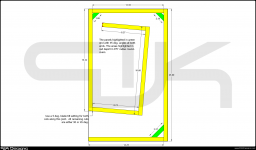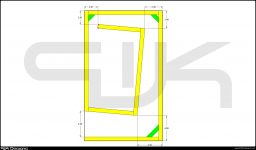Shizzon,
Sorry to hear how this is turning out for you. You have a good attitude and you are very good with construction. If you like going off on your own designs you might want to start with full range drivers to keep it simple. A good full range driver design can indeed sound and measure much better than a multiway at lower sound levels and is much more tractable from a design standpoint. Take a look at the foam core thread. I have used foam core boards to prototype speakers quickly and with minimal cost. You can verify a horn, TL, band pass design quickly before committing to wood. I have even made vey complicated tractrix horns and synergy horns. It's good that you like to learn, unfortunately you did it on a $1000 set of drivers and XO which really must be put into the Zaph designed box to truly be realized for what they are: a world class reference speaker system. You might try removing the inner divider wall and adding a bass reflex port to save this project if you want to keep it from going to the scrap pile.
http://www.diyaudio.com/forums/full-range/223313-foam-core-board-speaker-enclosures.html
Sorry to hear how this is turning out for you. You have a good attitude and you are very good with construction. If you like going off on your own designs you might want to start with full range drivers to keep it simple. A good full range driver design can indeed sound and measure much better than a multiway at lower sound levels and is much more tractable from a design standpoint. Take a look at the foam core thread. I have used foam core boards to prototype speakers quickly and with minimal cost. You can verify a horn, TL, band pass design quickly before committing to wood. I have even made vey complicated tractrix horns and synergy horns. It's good that you like to learn, unfortunately you did it on a $1000 set of drivers and XO which really must be put into the Zaph designed box to truly be realized for what they are: a world class reference speaker system. You might try removing the inner divider wall and adding a bass reflex port to save this project if you want to keep it from going to the scrap pile.
http://www.diyaudio.com/forums/full-range/223313-foam-core-board-speaker-enclosures.html
Shizzon, not all is lost, just close that damn port on the front...
You still have a 42in long sealed TL that will cause reflections. Either put lots of stuffing into the once open "horn" or perforate the internal divider to turn itona brace. Then seal or go with a BR vent.
Convert to BR fix
I don't know the internal depth of your box, but assuming that if you sealed up the front vent mouth and perforated the divider wall, you can get 39 liters. Assuming a 39L volume, put a 3in dia x 10in long rear facing bass reflex vent towards the bottom and you can get the response to flatten out like this. Here is 4pi space - no reflections but baffle step losses accounted for. Assuming your baffle width is about the same as the original Zaph design, the XO should handle the -6dB loss due to baffle step for you. This takes care of all the lumps and dips from 150Hz to 700Hz. Sometimes, simpler is better. If your volume is different than 39L, use an adjustable length vent and tune to taste.
Hope this helps.
Here is the response of just the woofer with no XO applied:
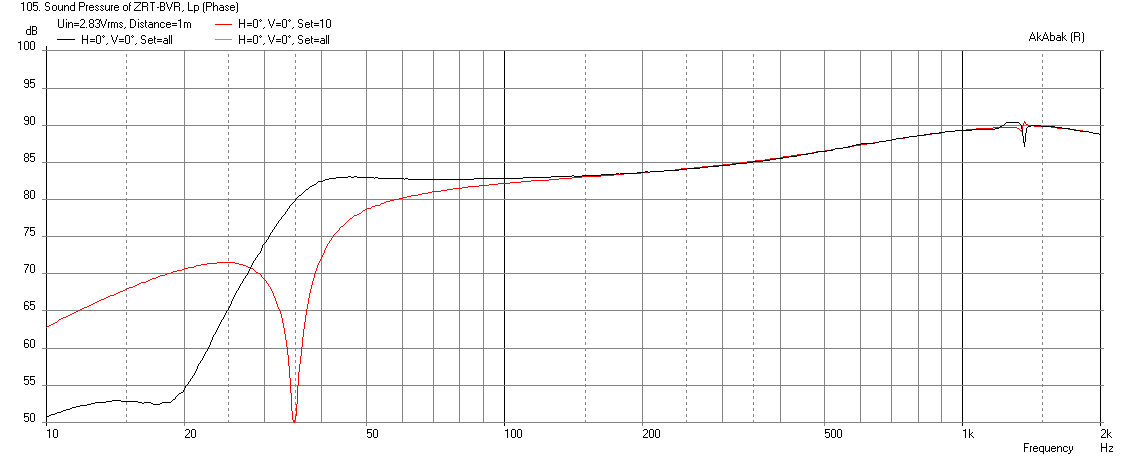
I don't know the internal depth of your box, but assuming that if you sealed up the front vent mouth and perforated the divider wall, you can get 39 liters. Assuming a 39L volume, put a 3in dia x 10in long rear facing bass reflex vent towards the bottom and you can get the response to flatten out like this. Here is 4pi space - no reflections but baffle step losses accounted for. Assuming your baffle width is about the same as the original Zaph design, the XO should handle the -6dB loss due to baffle step for you. This takes care of all the lumps and dips from 150Hz to 700Hz. Sometimes, simpler is better. If your volume is different than 39L, use an adjustable length vent and tune to taste.
Hope this helps.
Here is the response of just the woofer with no XO applied:

Attachments
It can be saved after all
I entered the Zaph XO parts into the Akabak script and placed speaker on a stand so that the woofer is at 40in above the ground and the speaker is 5 ft away from a back wall for this sim. It appears that the Zaph XO indeed accounts for the proper baffle step loss. This speaker actually looks very good now with the BR vent positioned to be backwards firing and located -12in below centerline of woofer.
Here is predicted response with reflections and diffraction turned on:
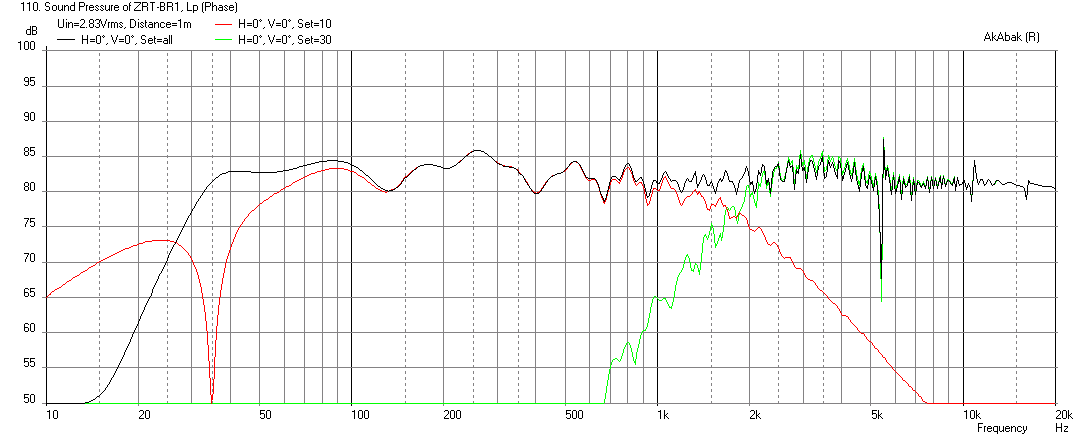
Compare this to what you currently have if you left it as is:
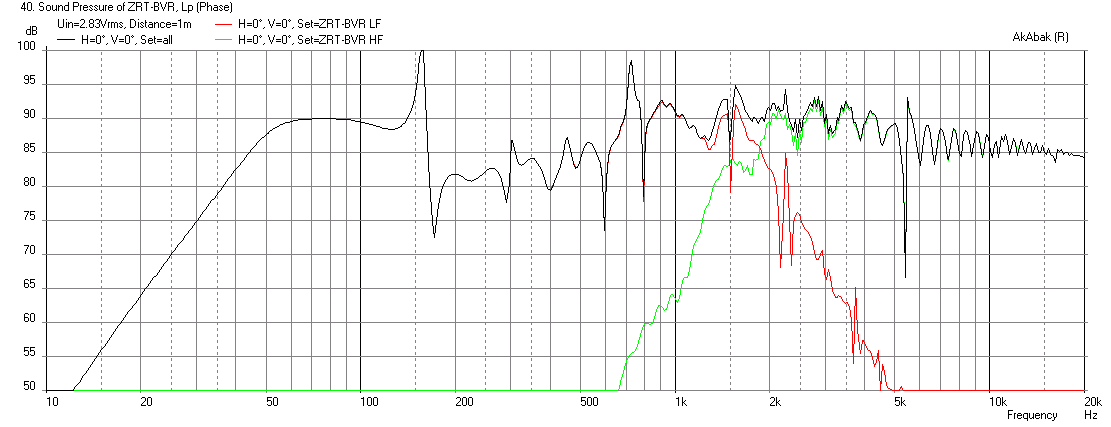
I entered the Zaph XO parts into the Akabak script and placed speaker on a stand so that the woofer is at 40in above the ground and the speaker is 5 ft away from a back wall for this sim. It appears that the Zaph XO indeed accounts for the proper baffle step loss. This speaker actually looks very good now with the BR vent positioned to be backwards firing and located -12in below centerline of woofer.
Here is predicted response with reflections and diffraction turned on:

Compare this to what you currently have if you left it as is:

Attachments
Last edited:
I have attached some drawings that show the internal geometry to give a better idea of what is going on and possibly show locations for a bass reflex vent. The difference being that the front baffle of my enclosure is 1.375" thick (still maintaining internal geometry), and that I placed a 1.65" bevel on the front top (at the time in my mind I was lowering the effective height of the baffle). this means that the tweeter is sitting at 4.65 (3 inches from bevel edge) inches from the top and the Woofer is 10.65 inches from the top (9 inches from bevel edge).
All of the internal panels are 3/4" (closer to .7" though). Due to access problems it may be difficult to adequately perforate the back panel of the compression chamber, but i am definitely interested in making these better, so I will take a look to see what can be done
Once again, thank you for all of your time xrk971, you really didn't have to go through the trouble of doing this for me.
All of the internal panels are 3/4" (closer to .7" though). Due to access problems it may be difficult to adequately perforate the back panel of the compression chamber, but i am definitely interested in making these better, so I will take a look to see what can be done
Once again, thank you for all of your time xrk971, you really didn't have to go through the trouble of doing this for me.
My 39 liter guess is just about spot on based on the dimensions you provided. Maybe 38 L with volume of internal panel and corners subtracted but that won't change things much from vent tuning standpoint. Get a 2in Forstner bit with long extension like the kind used for installing in wall wires. Drill as many holes as you can using driver cutout as access and vent mouth as access. Then add stuffing inside but careful not to block vent. Mount vent 2.5 in from bottom on back side. It may work from front side too if you prefer front firing. Use 3in sch 40 PVC if you can't find real vent long enough.
Good luck.
Good luck.
Front vent placement would be a bit easier I could place the vent on the insert that I would be using to plug the existing horn/vent. Any reason to go rear vent over front besides cosmetics?
Front vents have a little bit of HF sound leaking through but not a big deal. If easier go for it. Some prefer rear vent for an exaggerated bass if near back wall.
Hi xrk971, I am just wondering the reason for the 10" long 3" ID port as apposed to the 4.75" long 2" port that is the default in the Zaph 38L vented configuration. It would seem that the larger ID port would result in lower air velocities and possibly reduce port noise or "chuffing", but I would just like to know why. The 2" ID ports would be a bit easier to implement than the 3" ID, especially when you consider fitting the internal flare into the existing geometry.
I am not doubting your analysis, just trying to get a handle on some of the reasoning behind one port ID verses the other considering that the effective internal volume of what I am working with is close to that the the 38L Zaph option.
I am not doubting your analysis, just trying to get a handle on some of the reasoning behind one port ID verses the other considering that the effective internal volume of what I am working with is close to that the the 38L Zaph option.
You can go with smaller port dia - I was using that to minimize velocity but if Zaph used 2in or whatever then go with that. It should be fine. I did not look at the port velocities but a 2in dia port is appropriate for a 6.5 in to 7in class driver. Usually I go with 3in for 8in class driver. 2in dia is definitely easier to fit.
I'd say 2.5" ID being the smallest for a 6.5" size with a healthly Xmax. 2" creates too much turbulance for my taste.
I'd say 2.5" ID being the smallest for a 6.5" size with a healthly Xmax. 2" creates too much turbulance for my taste.
For a 2.5 in ID vent use 6.5 in long vent. With a -12dB/oct HPF at 34Hz to prevent cone over excursion for low freq content, you can drive the woofer to 12.3volts. The peak velocity in a 2.5in dia vent will be 18.6 m/s at 35 Hz - which is a little high actually, so you may even want a 3in duct if you want to avoid chuffing. Another reason for a rear facing port (hear less of it).
Predicted response with HPF in place:
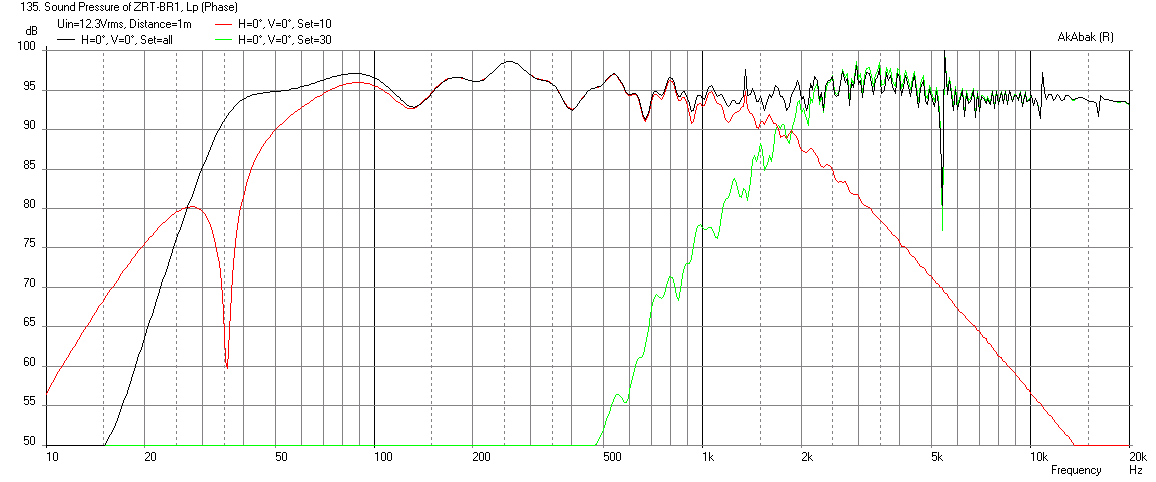
Cone displacement with HPF at xmax:

Impedance:

Velocity at port:

Impulse Response:

Attachments
-
 ZRT-BR-mod-with-Zaph-XO-Freq-1m-HPF.png47.2 KB · Views: 422
ZRT-BR-mod-with-Zaph-XO-Freq-1m-HPF.png47.2 KB · Views: 422 -
 ZRT-BR-mod-with-Zaph-XO-Displacement-HPF.png25.2 KB · Views: 408
ZRT-BR-mod-with-Zaph-XO-Displacement-HPF.png25.2 KB · Views: 408 -
 ZRT-BR-mod-with-Zaph-XO-Velocity-HPF.png24.1 KB · Views: 407
ZRT-BR-mod-with-Zaph-XO-Velocity-HPF.png24.1 KB · Views: 407 -
 ZRT-BR-mod-with-Zaph-XO-Impulse-HPF.png15.7 KB · Views: 404
ZRT-BR-mod-with-Zaph-XO-Impulse-HPF.png15.7 KB · Views: 404 -
 ZRT-BR-mod-with-Zaph-XO-Impedance-HPF.png25.7 KB · Views: 403
ZRT-BR-mod-with-Zaph-XO-Impedance-HPF.png25.7 KB · Views: 403
I have completed the second enclosure and have listened to the pair in the standard configuration; while to my ear the sound they produce is still better than anything else I have heard, I do not want to leave any performance on the table and will go about with modifying the design to what xrk971 has suggested.
I will perforate the internal vents walls and seal up the enclosures port opening and add a suitable bass reflex vent. I am still undecided on if I want to have the bass reflex vent located on the front or rear of the enclosure; I will look into both possibilities and see what will work best with whatever bass reflex vent is chosen.
As far as the vent itself goes, it seems as though a number of options are possible to achieve the desired tuning (Zaph's default is 30 Hz). the Zaph enclosures utilize a 2" ID flared vent that is 4.75 inches long, other options that have been suggested here are a 2.5" ID vent at 6.5" long, as well as a 3" ID vent at 10" long.
It was mentioned that a -12dB/oct HPF at 34Hz would be used to prevent over excursion (with the 2.5" ID option). I would guess that the 3" ID configuration would also need a high pass filter to prevent over excursion on the lower frequencies? I am assuming that HPF is necessary due to the reduction in the pneumatic suspension that results from the larger vent ID, not sure if this is the case.
I will perforate the internal vents walls and seal up the enclosures port opening and add a suitable bass reflex vent. I am still undecided on if I want to have the bass reflex vent located on the front or rear of the enclosure; I will look into both possibilities and see what will work best with whatever bass reflex vent is chosen.
As far as the vent itself goes, it seems as though a number of options are possible to achieve the desired tuning (Zaph's default is 30 Hz). the Zaph enclosures utilize a 2" ID flared vent that is 4.75 inches long, other options that have been suggested here are a 2.5" ID vent at 6.5" long, as well as a 3" ID vent at 10" long.
It was mentioned that a -12dB/oct HPF at 34Hz would be used to prevent over excursion (with the 2.5" ID option). I would guess that the 3" ID configuration would also need a high pass filter to prevent over excursion on the lower frequencies? I am assuming that HPF is necessary due to the reduction in the pneumatic suspension that results from the larger vent ID, not sure if this is the case.
You might want to make a measurement as built before mods. You only need HPF if you plan on playing loud with music that has low freq content like movie soundtracks. For normal listening probably ok.
I currently do not have the tools to take the necessary measurements that would allow for a meaningful analysis of the speakers performance in the standard configuration. It would also be difficult for me to explain the cost/benefit of purchasing said equipment to my significant other.
I will ask around locally to see if someone i know has something that I can borrow; I am assuming that something like the Dayton Audio OmniMic V2 or equivalent would be required to take the desired measurements?
And thank you once again!
I will ask around locally to see if someone i know has something that I can borrow; I am assuming that something like the Dayton Audio OmniMic V2 or equivalent would be required to take the desired measurements?
And thank you once again!
Well that is much more reasonable than I was expecting, I was thinking that the necessary tools would run in the $300+ range.
Thanks for the heads up Greebster.
Thanks for the heads up Greebster.
I use the Dayton UMM-6 and I got it for $60, regularly $80. That and REW and you are set. You can do it for cheaper if all you need is a relative measure of bass/mid response from 20Hz to 5kHz using the Panasonic WM-61A mic capsule and some wiring. But best to go with the calibrated commercial measurement mic. USB mic is convenient because the ADC is built into the mic and doesn't need a sound card calibration.
- Status
- Not open for further replies.
- Home
- Loudspeakers
- Multi-Way
- Custom Zaph Audio ZRT 2 way build


